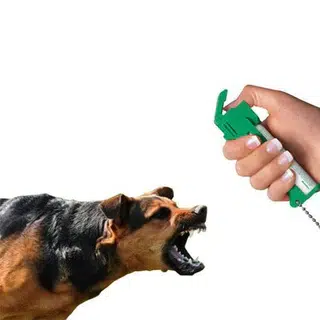Will Pepper Spray Work on Dogs? Introducing the effectiveness and science behind using pepper spray as a dog deterrent. There are times when we encounter aggressive dogs and need a reliable method to keep ourselves safe. Pepper spray has gained popularity for its potential to deter dogs effectively, but how does it actually work? In this article, we will explore the science behind pepper spray and its effectiveness as a dog deterrent.
Pepper spray primarily contains capsaicin, a chemical compound derived from chili peppers. When sprayed, capsaicin irritates the dog’s sensitive mucous membranes, causing intense burning, temporary blindness, and difficulty breathing. These effects typically last for about 30 minutes, giving you enough time to move to safety.
However, it’s essential to note that pepper spray should be used responsibly and as a last resort. While it may be an effective tool against aggressive dogs, it is crucial to be aware of local laws and regulations surrounding its use.
Join us as we delve into the science behind pepper spray and understand its effectiveness as a dog deterrent. Stay informed and stay safe!
Understanding pepper spray as a dog deterrent
Pepper spray is a non-lethal deterrent that can be used to ward off aggressive dogs. It is a concentrated liquid that contains capsaicin, the active ingredient responsible for its effects. When sprayed, the capsaicin irritates the dog’s eyes, nose, and throat, causing intense discomfort and pain. This reaction is a result of the interaction between capsaicin and the sensory receptors in the dog’s body.
The primary purpose of using pepper spray as a dog deterrent is to create a temporary distraction and disable the aggressive behavior of the dog. It is not intended to cause permanent harm or injury. Pepper spray is often used by mail carriers, joggers, and individuals who frequently encounter aggressive dogs in their line of work or daily activities.
How does pepper spray work
Pepper spray works by targeting the dog’s sensory receptors, specifically the pain receptors in the eyes, nose, and throat. When sprayed, the capsaicin in the pepper spray comes into contact with these receptors, causing a burning sensation and irritation. The intense discomfort and pain experienced by the dog can deter it from continuing its aggressive behavior and allow the person under threat to escape to safety.
Capsaicin affects the dog’s mucous membranes, which are highly sensitive. When exposed to capsaicin, these membranes become inflamed, leading to temporary blindness, difficulty breathing, and intense pain. The effects of pepper spray typically last for about 30 minutes, giving the person enough time to distance themselves from the aggressive dog and seek help if necessary.
It is important to note that the effectiveness of pepper spray may vary depending on factors such as the concentration of capsaicin in the spray, the distance from which it is sprayed, and the size and breed of the dog. Additionally, individual dogs may react differently to pepper spray, and some breeds may be more tolerant or resistant to its effects.
Effectiveness of pepper spray on dogs

Pepper spray has been widely regarded as an effective deterrent against aggressive dogs. Its primary purpose is to disable the dog temporarily and allow the person under threat to escape to safety. The intense burning sensation, temporary blindness, and difficulty breathing caused by pepper spray can significantly disrupt the dog’s aggressive behavior and create a window of opportunity for the person to remove themselves from the situation.
Numerous anecdotal accounts and testimonials from individuals who have used pepper spray to deter aggressive dogs support its effectiveness. Many report that the use of pepper spray has effectively stopped the dog’s attack or prevented it from escalating further. However, it is important to remember that each situation is unique, and the effectiveness of pepper spray may vary depending on various factors.
Research and studies on the use of pepper spray as a dog deterrent
While there is a lack of comprehensive scientific studies specifically focused on the use of pepper spray as a dog deterrent, some research has been conducted on its effectiveness as a general non-lethal deterrent. These studies provide insights into the potential effectiveness of pepper spray against aggressive dogs.
One study published in the Journal of Forensic Sciences examined the effects of pepper spray on human subjects and found that it effectively incapacitated individuals for a significant period of time. Although this study did not focus on dogs specifically, it suggests that pepper spray can have a similar effect on animals.
Another study published in the Journal of Applied Animal Welfare Science evaluated the use of pepper spray as a deterrent for aggressive dogs in a controlled setting. The study found that pepper spray effectively deterred the aggressive behavior of the dogs, leading to a reduction in the number of attacks.
While these studies provide some evidence for the effectiveness of pepper spray as a dog deterrent, further research is needed to fully understand its impact and effectiveness in real-world scenarios.
Safety considerations when using pepper spray on dogs
While pepper spray can be an effective tool against aggressive dogs, it is important to use it responsibly and with caution. Here are some safety considerations to keep in mind when using pepper spray:
- Read and follow the instructions: Familiarize yourself with the instructions provided by the manufacturer. Understand how to properly handle and use the pepper spray to maximize its effectiveness and minimize the risk of accidental exposure.
- Maintain a safe distance: Ensure that you are at a safe distance from the dog before using pepper spray. The recommended distance may vary depending on the specific product, so refer to the instructions provided by the manufacturer.
- Avoid spraying into the wind: Be mindful of wind direction when using pepper spray. Spraying into the wind may result in the spray blowing back towards you, causing accidental exposure and reducing its effectiveness against the dog.
- Avoid direct contact with the dog’s eyes: Aim for the general facial area of the dog rather than directly targeting its eyes. While the goal is to disable the dog temporarily, causing permanent harm or injury is not the intention.
- Seek medical attention if necessary: If you or the dog experience any adverse reactions or if accidental exposure occurs, seek medical attention immediately. While pepper spray is generally considered safe, individual reactions may vary, and it is always better to err on the side of caution.
Remember, pepper spray should be used responsibly and as a last resort. It is essential to prioritize personal safety and respect local laws and regulations regarding the use of pepper spray.
Alternatives to pepper spray for dog deterrence
While pepper spray can be an effective tool against aggressive dogs, there are also alternative deterrents that can be considered. Some common alternatives include:
- Ultrasonic devices: These devices emit high-frequency sound waves that are unpleasant to dogs, causing them to retreat. Ultrasonic devices can be handheld or mounted in specific areas to deter dogs from entering.
- Dog deterrent sprays: Similar to pepper spray, dog deterrent sprays are specifically formulated to deter dogs without causing permanent harm. These sprays typically contain a combination of natural ingredients that create an unpleasant odor or taste for the dog.
- Personal alarms: Personal alarms emit a loud, high-pitched sound when activated. The sudden noise can startle and deter aggressive dogs, giving you an opportunity to escape.
- Walking sticks or umbrellas: Carrying a walking stick or umbrella can serve as a physical deterrent against aggressive dogs. The mere sight of a larger object may discourage the dog from approaching or attacking.
It is important to assess the situation and choose the most appropriate deterrent based on personal comfort and safety considerations.
Tips for using pepper spray effectively as a dog deterrent
When using pepper spray as a dog deterrent, it is important to follow these tips to ensure its effectiveness:
- Be prepared: Carry pepper spray in easily accessible locations, such as a pocket or a holster, when venturing into areas where encounters with aggressive dogs are more likely.
- Stay calm and confident: Dogs can sense fear and aggression. It is important to remain calm and confident when using pepper spray. Your demeanor can influence the dog’s behavior and response to the deterrent.
- Practice proper aim and timing: Aim for the dog’s facial area, specifically the eyes and nose, to maximize the effectiveness of pepper spray. Timing is crucial, so spray when the dog is within range and avoid spraying prematurely.
- Consider self-defense training: Equipping yourself with self-defense techniques and training can provide you with additional tools and confidence when dealing with aggressive dogs. These techniques can help you assess the situation, de-escalate aggression, and use pepper spray effectively.
Remember, the goal is to deter the dog and create an opportunity to escape safely. It is important to prioritize personal safety and use pepper spray responsibly.
Mace Muzzle® Dog Repellent |
| |||
Frontiersman Bear Attack Deterrent Pepper Fog 9.2 oz. w/ Holster |
| |||
GrizGuard® Bear Attack Deterrent Pepper Fog 7.9 oz. w/ Quick Access Holster |
|
Legal considerations and regulations surrounding the use of pepper spray on dogs
Before using pepper spray as a dog deterrent, it is crucial to be aware of the legal considerations and regulations in your area. Different regions may have specific laws regarding the use of pepper spray, and it is important to comply with these regulations.
In some areas, the use of pepper spray on dogs may be prohibited or restricted. It is essential to research and understand the local laws governing the use of pepper spray to avoid any legal complications.
Additionally, it is important to note that using pepper spray on dogs may not be suitable in all situations. For example, if a dog is acting aggressively due to fear or pain, using pepper spray may escalate the situation and cause further distress.
Always prioritize your personal safety and consider alternative options if using pepper spray is not a viable or legal solution in your specific circumstances.
Conclusion: Weighing the pros and cons of using pepper spray as a dog deterrent
Pepper spray can be an effective tool for deterring aggressive dogs and creating a temporary window of opportunity to escape to safety. Its active ingredient, capsaicin, causes intense irritation and discomfort to the dog’s mucous membranes, leading to temporary blindness, difficulty breathing, and pain.
While pepper spray has been widely regarded as an effective dog deterrent, it is important to consider the specific situation, local laws, and individual factors before using it. Responsible use, proper aim and timing, and awareness of the potential alternatives are essential when using pepper spray.
Understanding the science behind pepper spray and its effectiveness as a dog deterrent can empower individuals to make informed decisions about their personal safety. By weighing the pros and cons and staying informed, we can better equip ourselves to handle encounters with aggressive dogs and ensure our well-being. Stay safe and be prepared!




